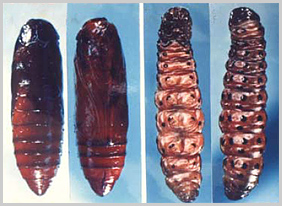Quick Overview of Teak Insect Pests
There are three well-known pests –
- Caterpillars of moth, Hyblaea puera, commonly known as the teak defoliator, which feed on the foliage during the early part of the growing season, soon after flushing. It is believed to cause one or more total defoliation events every year in most teak areas. The teak defoliator is a migrant pest, with shifting foci of high-density infestation during the early outbreak period, which coincides with pre-monsoon rains. This is followed by widespread infestation and sudden disappearance of the pest population.
- The teak leaf skeletoniser Eutectona machaeralisis also present in plantations in Java. This caterpillar feeds on the leaves, leaving the major veins intact, hence the name ‘skeletoniser’ and grasshopper.
- The third notable teak pest in Java is the termite Neoterme tectonae. Popularly known as “Inger-inger”, this wood-dwelling termite hollows out portions of stem and branches. The external symptoms, swellingof the trunk and branches, normally become visible 3-5 years after the initial attack. The termites occupy crevices within the swollen stem. Trees over 3 years old are attacked but the symptoms appear only later. This is a serious problem in Java and the thinning of infested trees is the only practical method to reduce the incidence of attack, although methods such as the introduction of fumigants, e.g. phostoxin, into the affected portion of the trunk have been tried.
The following teak pests are of lesser importance. The ambrosia beetle, Xyleborus destruens, attacks the trunk of living teak trees making a branching tunnels that extends into the heartwood. The teak beehole borer, Xyleutes ceramica, usually infests a small proportion of sampling in an 18-month old teak plantation. The grasshopper, valanga nigricornis causes sporadic defoliation and white grubs damage seedlings in nurseries.
Diseases
Teak is fairly resistant to diseases, although several pathogenic organisms have been recorded. A few diseases affect young trees in taungnya stems, notably, an unidentified root wilt and stem cancer, Corticum salmonicolor (pink disease).
